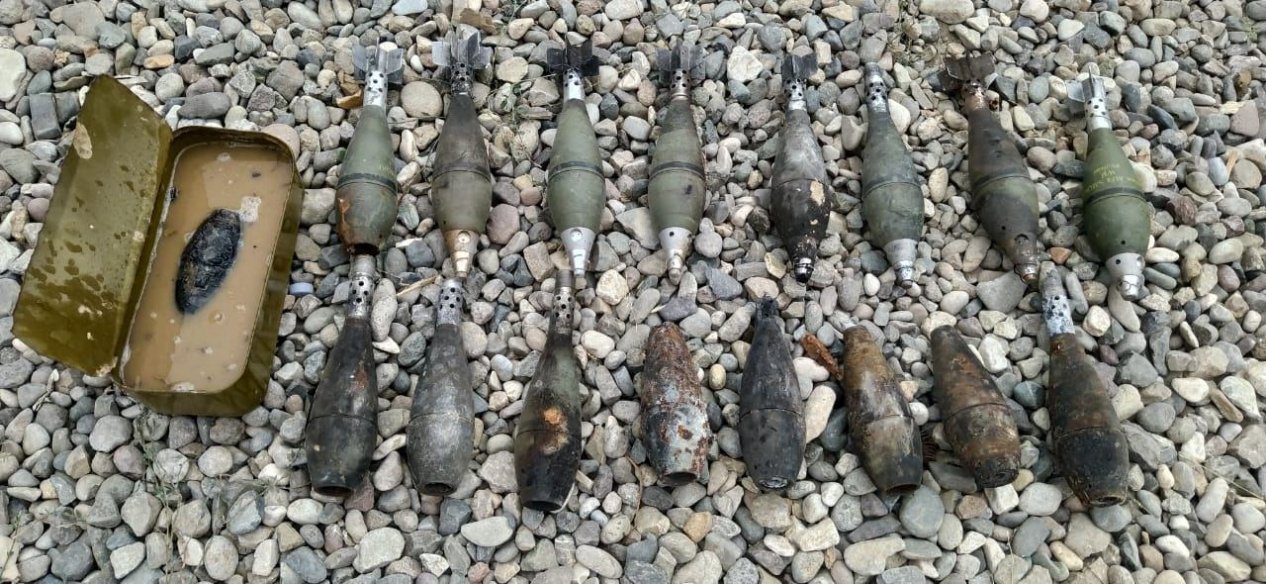
As the media reported yesterday, based on the State Border Service (SBS) appeal, on July 3, 2021, the Azerbaijan National Agency for Mine Action (ANAMA) began work to neutralize the former ammunition depot in the Jabrayil district. During the clearance operations carried out by the agency's specialists, 157 unexploded ordnance (UXO), 1,185 shells of various calibers, 5 kilograms of explosives (TNT), and 17 phosphorus shells for an 82-mm mortar were found.
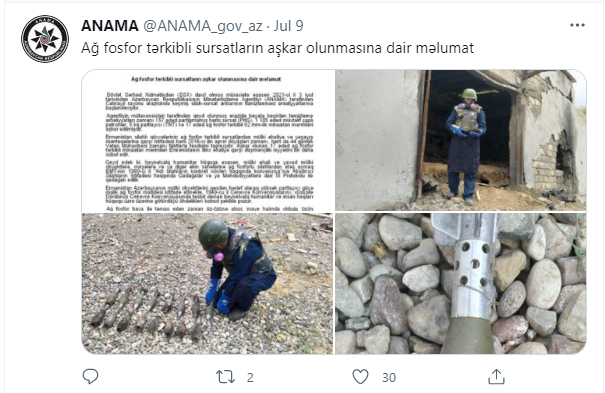
To begin with, the use of phosphorus shells by the Armenian side during the second Karabakh war was denied by Armenia and was questioned by its supporters. However, the evidence remaining in the liberated territories suggests otherwise.
During the 44-day war, there were numerous reports that the Armenian Armed Forces used ammunition with white phosphorus. On November 3, the Assistant of the President of the Republic of Azerbaijan Hikmet Hajiyev tweeted about the use of phosphorus shells by the Armenians against the residents of Azerbaijan's Tartar district.
Attacks on civilians or civilian objects, as well as on forests or other types of vegetation using projectiles containing white phosphorus, are prohibited by Protocol III on Prohibitions or Restrictions on the Use of Incendiary Weapons to the 1980 UN Convention on Certain Conventional Weapons, Hikmet Hajiyev said.
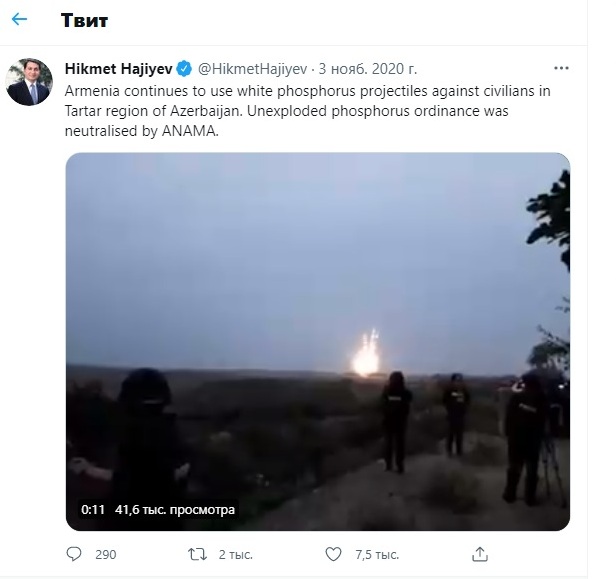
FOTO Hikmet Hajiyev
The finding in Jabrayil is not the first. On December 25 last year, 22-mm shells with white phosphorus D-4 (P-4) were found on the territory of the former enemy post in the liberated from the occupation Sugovushan village of the Tartar district.
At the end of the 44-day war, Armenia, in response to accusations of using prohibited substances, rushed to accuse Azerbaijan of "using phosphorus ammunition against the peaceful population of Nagorno-Karabakh." The Ombudsman of Armenia Arman Tatoyan stated this on his Facebook page and accused the Azerbaijani Army of deliberately setting fire to forests near civilian settlements.
The Azerbaijani Defense Ministry reacted dryly to the disinformation, pointing out on its official Facebook page that the information disseminated by the Armenian media that the civilian population was injured as a result of the alleged shelling of the Garabulag village in the Khojaly district by the Azerbaijani Army was untrue.
"We officially declare that the Azerbaijani Army fires only at military targets and not at the civilian population," the ministry said.
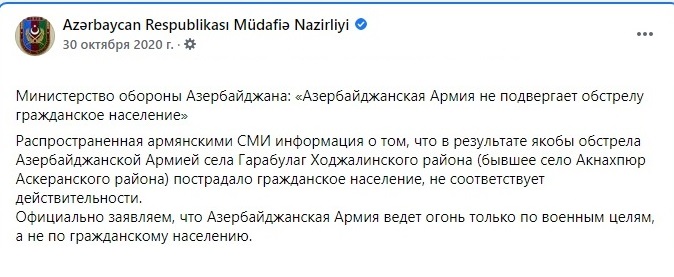
PHOTO the Ministry of Defense
Armenia, despite the uproar it made, failed to support its accusations with evidence. The charges were denied, including by impartial parties. For example, a military expert, retired captain of the first rank Vasily Dandykin found the video published by Arman Tatoyan unconvincing. "What is depicted there can be anything, even smoke bombs," he said.
The head of the Center for Military Forecasting Anatoly Tsyganok also expressed doubts. "It is known that Israel used phosphorus munitions against the Gaza Strip. There is video footage: a rocket flies, opens up, and phosphorus pours out of it. This is not the case here," he noted.
The fact that Armenia used prohibited substances both in the first Karabakh war and during the April 2016 battles proves the credibility of the information about detecting phosphorus shells used during the war by the Armenian side in the liberated territories.
In May 2016, the Azerbaijani Foreign Ministry issued a statement, which noted that the Armed Forces of Armenia, along with the shelling of the civilian population and civilian objects from heavy artillery and large-caliber weapons, also deliberately used a phosphorus artillery shell with a chemical filling. On May 10, ANAMA discovered an unexploded phosphorus artillery shell in the territory of the Askipara village of Tartar district, which was destroyed on May 11 by the agency's specialists with the participation of military attachés of embassies accredited in Azerbaijan and field assistants of the personal representative of the OSCE Chairman-in-Office. The investigation revealed that the unexploded ordnance found in Askipara was a shell from a 122 mm D-4 type cannon (smoke projectile), which contains 3.6 kg of P-4 (chemical code of white phosphorus).
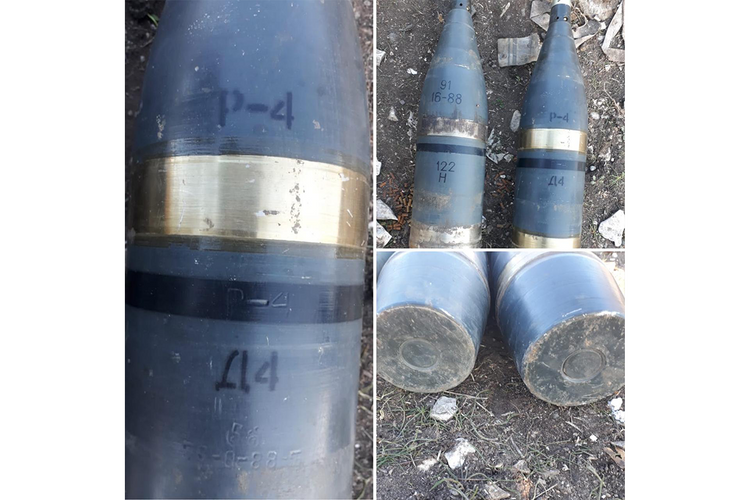
Together with the country's Defense Ministry, the Azerbaijani Foreign Ministry organized a trip of military attaches to the Askipara village of the Tartar district, where the unexploded phosphorus ordnance was found during the ANAMA operations on Tuesday. The military attaches and diplomats got acquainted with the situation on the spot. The projectile was destroyed by detonation after being recorded and documented since it was not suitable for transportation.
The use of phosphorus projectiles is prohibited by Protocol III of the Convention on Prohibitions or Restrictions on the Use of Certain Conventional Weapons Which May Be Deemed to Be Excessively Injurious or to Have Indiscriminate Effects (1980).
White phosphorus weapons can also be classified as "incendiary weapons or devices" under the 1997 International Convention for the Suppression of Terrorist Bombings, which Armenia acceded to in 2004. The prohibition applies to the use of "a weapon or device designed or capable of causing death, serious injury or substantial material damage through the release, dispersal or exposure to toxic chemicals, biological agents or toxins or similar substances, or radiation or radioactive material."
The well-known (now deceased) Russian military expert Alexei Sinitsyn told reporters earlier about Armenia's widespread use of chemical weapons in the first Karabakh war.

PHOTO Alexei Sinitsyn
"In April 1992, I left for Shusha at the request of my old friend, the military commandant of the city, Alakbar Asgarov. We agreed to meet at one of the posts in a wooded area. Upon arrival, I saw a strange picture - most of the fighters had a scarlet rash with uneven edges on their bodies, and some even had blistering and slipping skin. Alakbar and I spent a long time unsuccessfully trying to figure out the reasons for this mysterious ailment until one of the soldiers remembered a short artillery bombardment from the Armenian side a week ago. We literally plowed the whole area on our bellies but still collected several dozen rusted so-called "arrow-shaped elements," i.e., small shooters, which equip artillery shells. And the next day, the same red pimpled rash appeared on our bodies and especially on our hands. There could be no doubt - the Armenians used the shells with chemical warfare agents (CWA).
We had a non-professional cameraman with us, and I filmed a TV report about this chemical attack on Azerbaijani positions. From a retransmitter in Shusha, we transferred the material to AzTV. I will not go into details, but I will say that by titanic efforts, this report was sent to Moscow and shown on Central TV, the newly created Russian television.
Literally, two days later, journalists, including foreign ones, some experts, a commission of the Azerbaijani Health Ministry, and long-awaited doctors arrived in Shusha. Then they all agreed that the Armenians in the area between Lachin and Shusha used ammunition with banned toxic substances. A few days later, both Shusha and Lachin fell, and the story of the 'chemical bombardment' ceased to interest anyone," Sinitsyn said.
A serious investigation of Armenia's use of chemical weapons was carried out by the Lithuanian military reporter, the first Karabakh war participant, Ričardas Lapaitis. While on the front lines, he witnessed many terrible facts.
For the first time, the military structures of Armenia used chemical weapons against Shusha, according to Lapaitis's investigation published later.
In May 1992, another chemical attack was carried out in the city of Sadarak (Nakhchivan Autonomous Republic). Aghdam in Lower Karabakh was also subjected to chemical shelling. Only on May 12, 1992, 15 bombs exploded in this city. Four of them fell on the territory of the central hospital, January 20, Fuzuli, Mashadi Abbas, and Sabir streets were hit by one bomb each, and seven others fell on private houses. The wounded survivors of the chemical attack were taken to the central hospital in Baku. The forensic medical examination revealed the presence of mustard gas, phosgene, and toxic substances of the cyanide group on their bodies. But after resuscitation, the wounded died. The doctors were powerless. Signs of ailment were as follows: severe choking, kidney failure, watery skin ulcers, slow heart rate, and heart failure. Aydin Huseynov (1969), wounded in Aghdam, was taken to the hospital at about 10 pm. At three o'clock in the morning, the doctors pronounced him dead.

PHOTO Lapaitis
Soon, prohibited weapons began to be used openly. The village of Munjuklu in Azerbaijan's Tovuz district was shelled on June 5, 1992. Substances of the cyanide group were found there. Such shells also exploded in the town of Jabrayil. One of them fell near the boarding school building. In the same year, Tartar, another city of Karabakh, was attacked. Four chemical shells hit the city center, three more fell on the territory of the district. Many civilians were killed. The chemical attack was also directed against the residents of the Fuzuli district. Not only chemical bombs but also cartridges were used there. Snipers shot and killed five residents.
A letter from the Azerbaijani Ministry of Health to the Ministry of Internal Affairs described the contents of the exploded bombs. It contained a warning that the Armenian forces are using chemical weapons not in isolated cases, as previously thought, but on a large scale. For this reason, many civilians died. The findings mentioned that the bombs are loaded with small needles, the ends of which are like drills. If even one of them falls into a person, death occurs after a few hours. Substances especially dangerous for human health were discovered: mustard gas, phosgene, diphosgene. "Investigating war crimes, I met with a high-ranking official of the Azerbaijani Ministry of Health. He gave me the results of laboratory tests, death certificates, the names of the victims and the names of the places where the chemical attacks were carried out.
A letter from the Azerbaijani Health Ministry to the Ministry of Internal Affairs described the contents of the exploded bombs. It contained a warning that the Armenian forces are using chemical weapons not in isolated cases, as previously thought, but on a large scale. For this reason, many civilians died. The findings mentioned that the bombs were loaded with tiny needles, the ends of which were like drill bits. A person hit by one of these dies within a few hours. The discovered hazardous substances were mustard gas, phosgene, diphosgene.
"Investigating war crimes, I met with a high-ranking official of the Azerbaijani Ministry of Health. He gave me the results of laboratory tests, death certificates, the names of the victims and the names of the places where the chemical attacks were carried out.
"While investigating the war crimes, I met with a high-ranking official of the Azerbaijani Health Ministry. He gave me the results of laboratory tests, death certificates, the names of the victims, and the names of the places where the chemical attacks were carried out.
Returning from the war zone, I also visited the Lithuanian Health Ministry and provided the collected facts. Disaster medicine consultant J. Dževečka agreed to answer my questions. I learned that these are very dangerous, illegal substances. People, once in their zone of action, begin to suffocate. The droplets that enter the body burn the internal organs. Mustard gas and phosgene are especially dangerous. Up to 50 percent of residents who fall into their zone of action die. The rest receive such large doses that exceed the lethal doses by 3-50 times. After the explosion of a large bomb, the cloud can spread over 20-30 km. With a small blast, it spreads over an area of 200-300 sq. m. Substances can accumulate in lowlands, poison the surface of the soil and water," Ričardas Lapaitis wrote.
Thus, we can definitely say that the information provided by the Azerbaijan Mine Action Agency is accurate. During our investigation, we became convinced that the use of phosphorus and other chemical warfare agents is a common practice in Armenia.




















